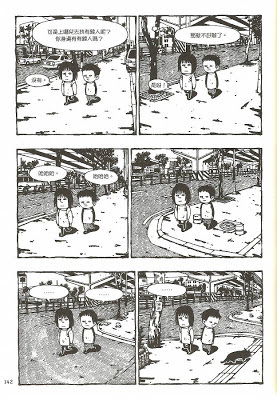PUBLISHED
BY 遠流
2011-2-1
PAGE : 302
ISBN: 9789573267515
PAGE : 302
ISBN: 9789573267515
Copyright Row-long Chiu & 遠流 Publishing house
Seediq
Bale –
Warriors of the Rainbow,
a history documentary comic which take Row-long
Chiu more
than 10 year to finished its research and drawing, published in 2004
as its original name" Wushe
Incident"
and republished in 2011 with the adopted movie made by Wei Te-Sheng.
WusheIncident was
an action from Seediq ethnic (indigenous in Taiwan)
to against the Japanese in 1930.
Author
show the beautiful landscape with a realistic style, the costume
with a very fine research, and the action with a excellent tempo.
Reader could understand all the cause
and consequence
of this incident,
the change of the position and the emotion, and the detail of the
strategy of both in these 250 pages, a documentary comic with this
scale is very rare in Taiwan. The time and the passion which Chiu
spent, were not only for making a comic but also to express what he
had been touched
to the other.
Chiu
went to Wu She by a coincidence, and he met someone who lived this
incident and someone who work for the document
of local history. Chiu
is somebody who always want to clarify everything. He began to stay
longtime in the tribe
and became a real friend with these local people, that was why he
could finally got a lot of discussion non official and personal. This
is one of the most important part about a reported comic of a history
documentary comic. If the other is not someone very intimate with
author, it is very difficult to get a profound content or a personal
position with only one interview, it's a question of confidence.
As
a history documentary, this comic is very clear and affluent, we can
understand how things happened, which is the first propose of the
author. But all the composition of image and the structure follow the
"action" and the development of the incident, but rarely
put the focus on the character and the humanity, so it's not easy for
the reader to notice the inner side and the spirit of the Seediq.
In
the interview of Chiu,
we saw him talked about how the Seediq treat something tough, the
difficulty for them to speak out this incident, the important of
Gaya, what Seediq Bale real means, and the special way the Seediq
treat their enemy…etc. After these complete research if all these
thing could be underline in this comic, i think it would be a more
profound and influential work.
This
comic is draw with a fine-illustration style, which we saw often on
the history book. The research of costume and tool is very
well-studied and the landscape and the architecture are full of
complicated effect-lines. But after a huge work like these, the
drawing lacks some personal character or style.
In
the taiwan version, we can see the color design setting which Chiu
made for the movie. This drawing has a very personal style, and we
saw a clear segmentation between the Seediq who wearing in red and
white and the Japanese army who wearing in green. I think it could
be nice to use it in the comic (but anyway, the comic version made
longtime before!).
Although
i mention a fews points could be perfect, but i still highly respect
all the work for this book. and i also recommend you to read this
book and understand the situation of an indigenous group under the
colony, and how brave and battle-wise they are.
In September, this book is going to publish in France, hope to see an english version very soon.
At the end , i would like to present you a Taiwanese music group who make a music album which is inspire from the Seediq culture and their history.
I also have a publishing house which produce Asia documentary graphic work, if you are interested in it, you can check out the website of SLOWORK PUBLISHING
































